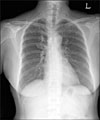Abstract
The pandemic (H1N1) 2009 influenza outbreak coincided with the typical Scrub typhus season, which can lead to diagnostic difficulties due to their similar and non-specific symptoms. Here we describe a case of laboratory confirmed co-infection of Pandemic (H1N1) 2009 influenza and Scrub typhus and discuss the difficulties in distinguishing the two illnesses clinically.
Figures and Tables
References
1. Centers for Disease Control and Prevention (CDC). Swine influenza A (H1N1) infection in two children--Southern California, March-April 2009. MMWR Morb Mortal Wkly Rep. 2009. 58:400–402.
2. Kim WJ. Epidemiology, clinical manifestations, and management of pandemic novel Influenza A (H1N1). Korean J Med. 2009. 77:157–164.
3. Seong SY, Choi MS, Kim IS. Orientia tsutsugamushi infection: overview and immune responses. Microbes Infect. 2001. 3:11–21.
4. Kim DM. Clinical features and diagnosis of scrub typhus. Infect Chemother. 2009. 41:315–322.
5. Suttinont C, Losuwanaluk K, Niwatayakul K, Hoontrakul S, Intaranongpai W, Silpasakorn S, et al. Causes of acute, undifferentiated, febrile illness in rural Thailand: results of a prospective observational study. Ann Trop Med Parasitol. 2006. 100:363–370.
6. Senanayake SN. Swine flu update: bringing home the bacon. Med J Aust. 2009. 191:138–140.
7. Na S, Kim MN, Kim WY, Kim W, Hong SB, Lim CM, et al. Prevalence and clinical features of pneumonia in patients with laboratory-confirmed pandemic influenza A H1N1 2009 infection in South Korea. Scand J Infect Dis. 2011. 43:19–26.
8. Writing Committee of the WHO Consultation on Clinical Aspects of Pandemic (H1N1) 2009 Influenza. Bautista E, Chotpitayasunondh T, Gao Z, Harper SA, Shaw M, et al. Clinical aspects of pandemic 2009 influenza A (H1N1) virus infection. N Engl J Med. 2010. 362:1708–1719.
9. Mueller MR, Smith PJ, Baumbach JP, Palumbo JP, Meek JI, Gershman K, et al. Influenza testing and antiviral prescribing practices among emergency department clinicians in 9 states during the 2006 to 2007 influenza season. Ann Emerg Med. 2010. 55:32–39.
10. Chang WH. Current status of tsutsugamushi disease in Korea. J Korean Med Sci. 1995. 10:227–238.
11. Park JI, Han SH, Cho SC, Jo YH, Hong SM, Lee HH, et al. Outbreak of hepatitis by Orientia tsutsugamushi in the early years of the new millenium. Korean J Hepatol. 2003. 9:198–204.
12. Polakos NK, Cornejo JC, Murray DA, Wright KO, Treanor JJ, Crispe IN, et al. Kupffer cell-dependent hepatitis occurs during influenza infection. Am J Pathol. 2006. 168:1169–1178.
13. Daudé M, Mansuy JM, Guitard J, Basse G, Esposito L, Izopet J, et al. Influenza A (H1N1) virus-induced hepatocellular injury in a kidney transplant patient. Transpl Infect Dis. 2011. 13:70–72.
14. Tullu MS. Oseltamivir. J Postgrad Med. 2009. 55:225–230.
15. Park KH, Lee SO, Choi SH, Kim MN, Lee JH, Yi H, et al. Successful salvage therapy with inhaled zanamivir in a patient with peramivir-resistant pandemic influenza A (H1N1) 2009 virus. Scand J Infect Dis. 2011. 43:151–155.




 PDF
PDF ePub
ePub Citation
Citation Print
Print



 XML Download
XML Download